Jonathan Gold’s 101 Best Restaurants: 50-26
More: 1-25 | 51-75 | 75-101
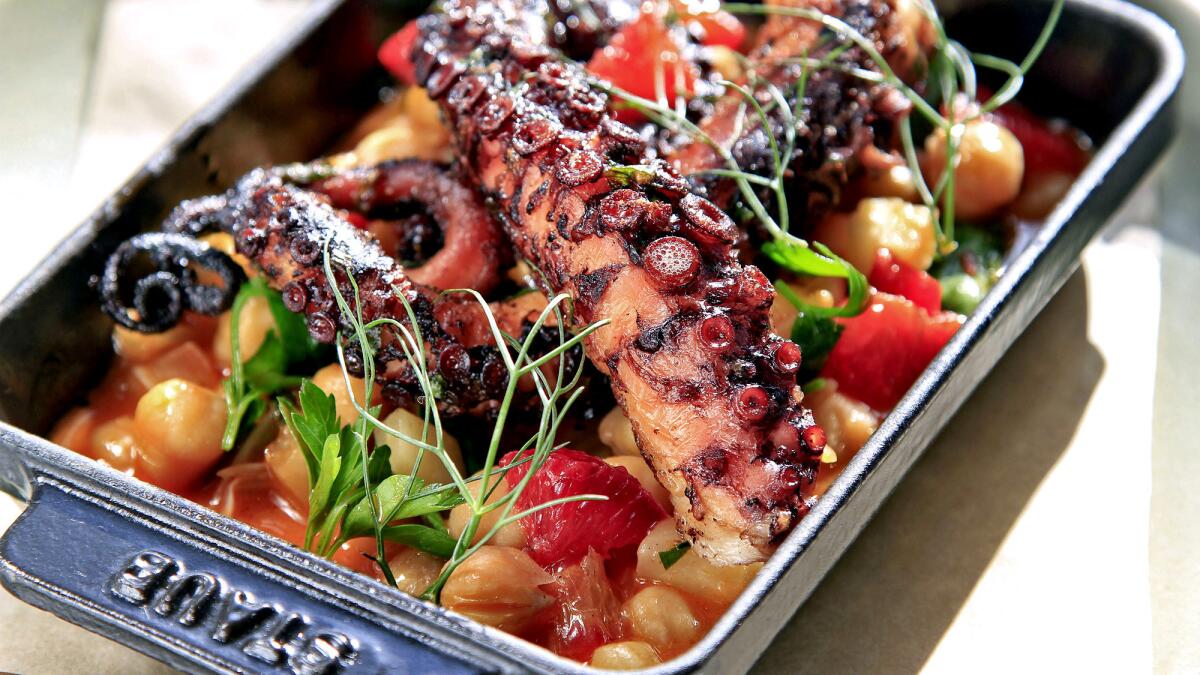
50 Tar & Roses
"Tar and roses" is the standard wine-geek description of the scent of Barolo wine. Tar & Roses, on the other hand, smells a lot like the smoldering oak that Andrew Kirschner passes most of his food through, onto or around in what is probably the purest distillation of the grill-centered small-plates fixation. Been a while since you've encountered popcorn with bacon, roasted marrowbones with sourdough or chicken oysters on a stick? You'll find them here, along with kale salad, cauliflower steak and a dish of wood-roasted peas with mint and sea salt that is among the most delicious things to come out of this decade. In 2025, Tar & Roses is the restaurant we're all going to be nostalgic for.

49 Drago Centro
Downtown is thick with experimental restaurants, funky restaurants, cocktail-centered restaurants and representatives of national chains. What seem to be missing from the area are grand restaurants, which is where Drago Centro comes in. Because if there can be said to be anything lacking in the seat of Celestino Drago's restaurant empire, it is not a sense of occasion. It is thrilling to walk into the triple-height dining room with its industrialist's view of downtown, to settle on a bottle of Barbaresco and to have a meal of Ian Gresik's burrata with favas, spaghetti Trapanese and duck breast with beets presented to you as if they were great gifts. Game is especially wonderful in season, and there are small bites at the bar up front.
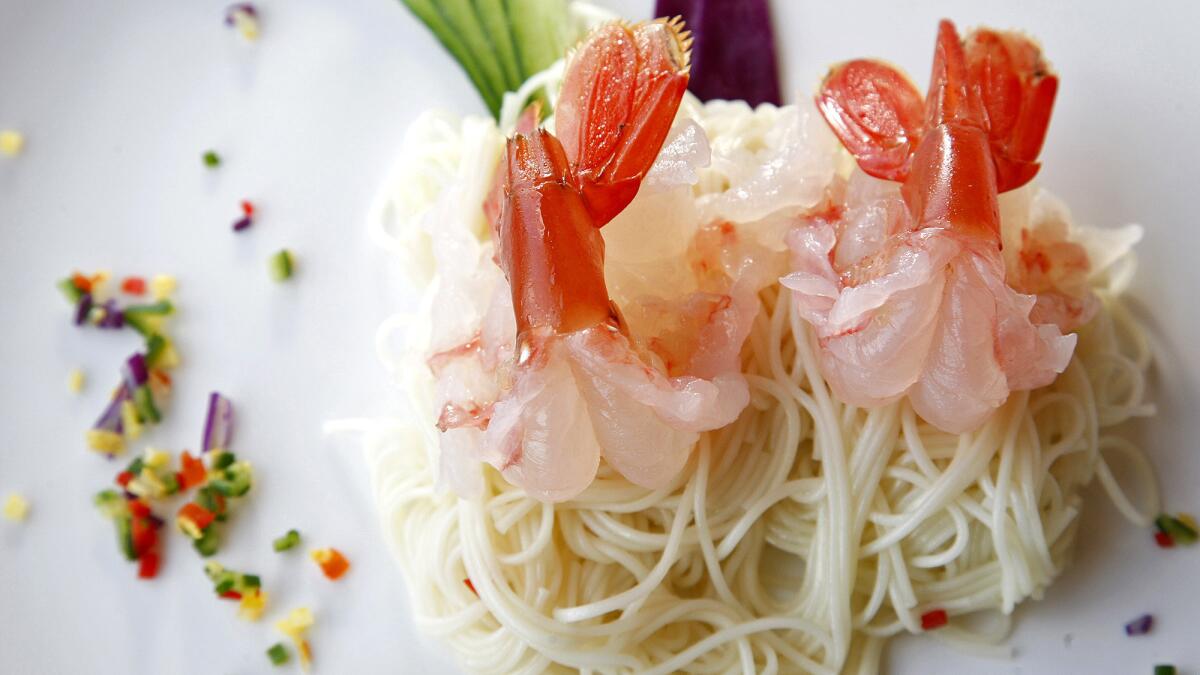
48 Sea Harbour
Sea Harbour is the best Hong Kong-style restaurant in the Los Angeles area, a comfortable dining room with impeccable live seafood and deft interpretations of Chinese luxury dishes. If you are looking for bird's nest, braised sea cucumber or sun-dried abalone preparations, I would recommend the restaurant without hesitation. You can blow thousands of dollars, but if you stay away from the allure of the live tanks, you can get away with spending very little. It also serves the best dim sum in the San Gabriel Valley, the har gow, shiu mai and sugar-crusted custard buns to which the other dim sum parlors aspire. Its rear dining room is lined with signed photographs from the Hong Kong singers and movie stars who frequent the place when they are in Los Angeles.
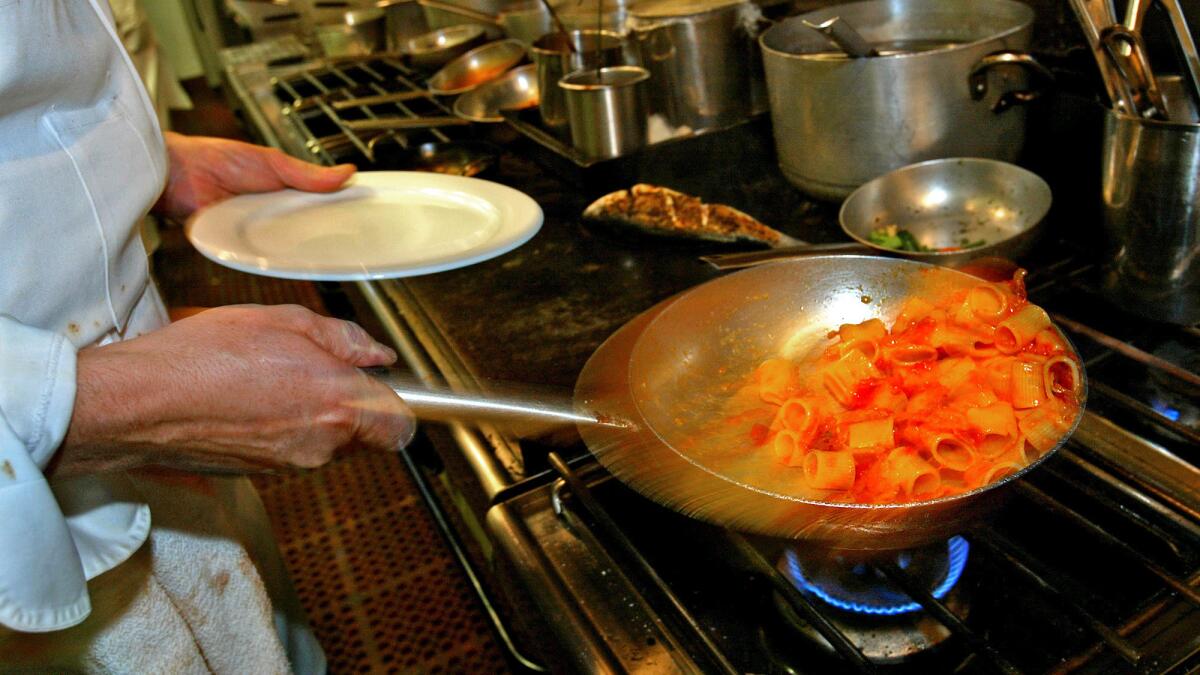
47 Angelini Osteria
Gino Angelini is among the most skillful of the old-school Italian chefs in town, renowned for his delicate fish dishes and his vegetable-thickened sauces since the last days of Rex, and for his updates of the classic dishes of his native Rimini. But while Angelini Osteria does not feature Angelini's most refined cooking, it is everyone's favorite, an informal room with well-designed trattoria cooking and a place to settle into for a plate of bombolotti or oxtail on Wednesday, Grandma's green lasagna or peppery pollo alla diavola — and where whatever diet you happen to be on at the time will be accommodated without a fuss. Some nights, it feels as if everybody in the room knows one another.

46 Salt's Cure
When you get into the habit of visiting the Salt's Cure Facebook page, it is really hard to stop. Each afternoon brings a photograph of that evening's chalkboard menu, shot from an oddly low angle. Each photo of the chalkboard inspires daydreams of Tamworth pork chops or Hampshire pork chops, milk-braised pork shoulder or porter-braised pork shoulder, creamed soup made with celery, asparagus or leeks. You always kind of get the same thing there, sitting at the long counter — meat or fish seared into rude deliciousness, a big plate of vegetables, a bottle of rough red wine — but somehow it is always different, depending on what kind of produce flows through the kitchen. And even if you're not one of the people who show up here two or three times a week, by the end of a meal, you kind of wish you were. Salt's Cure is also notable for its weekend brunches of oatmeal pancakes, house-cured bacon, grapefruit pie and hot biscuits with jam.
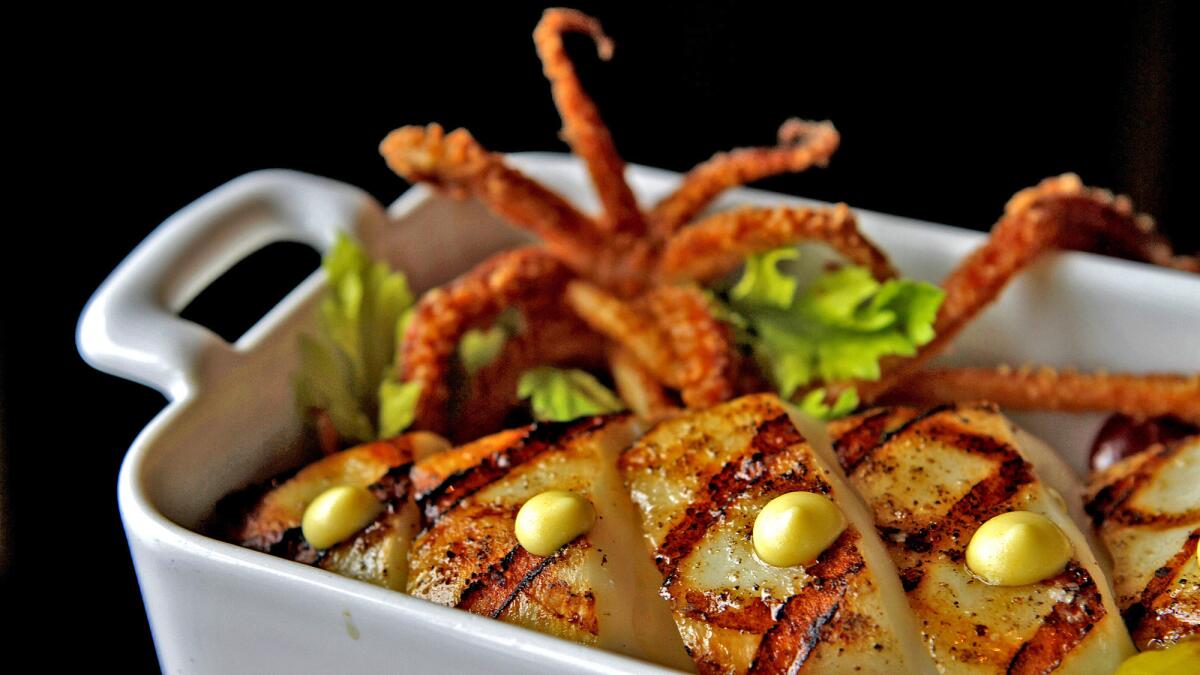
45 Manhattan Beach Post
In the last 10 years, Manhattan Beach has gone from a slouchy beach town to an overheated destination, where the boutiques no longer specialize in only costume jewelry and beachwear. And if any chef could be said to be propelling condo prices in the neighborhood, it is David LeFevre, whose Fishing With Dynamite is the superb raw bar this neighborhood has always needed and whose Manhattan Beach Post right next door is a redoubt of meaty, spicy, vegetable-intensive gastropub cooking. With its barbecued lamb belly, grilled local sword squid with lemon curd, bacon-cheddar biscuits and soft hunks of braised hog jowl in Vietnamese-inspired fish-sauce caramel, MB Post is exactly the restaurant you'd want to cater your tailgate party.
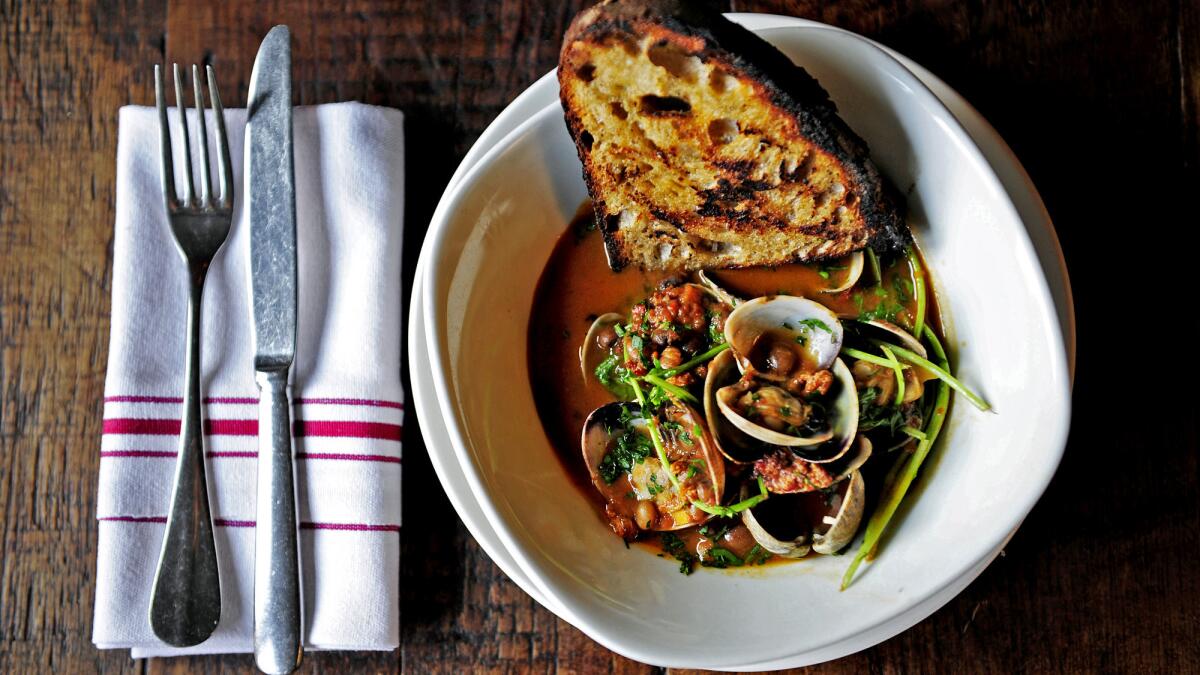
44 Sotto
Sotto is a southern Italian place dedicated to local produce and sustainable, artisanally produced meat; a shrine to the awesome heat of its 15,000-pound oven insulated with imported Neapolitan dirt. Chefs Steve Samson and Zach Pollack come from Ortica, the South Coast Plaza restaurant that redefined Orange County pizza, and the pies emerging from the wood-burning Vesuvius are soft-centered, elastic and leopard-spotted with character-building circles of char. If you should happen across a special of lamb innards or fennel-crusted pork chops, make sure to order it the second you sit down. Even the pastas tend to be southern things we haven't seen locally, like fileja Calabrese with sausage and greens or the twisted noodles here called casarecce (which means nothing more than "homemade") with a thick paste of simmered lamb thickened with egg yolk and sheep cheese. For dessert — take the cannoli. We swear.
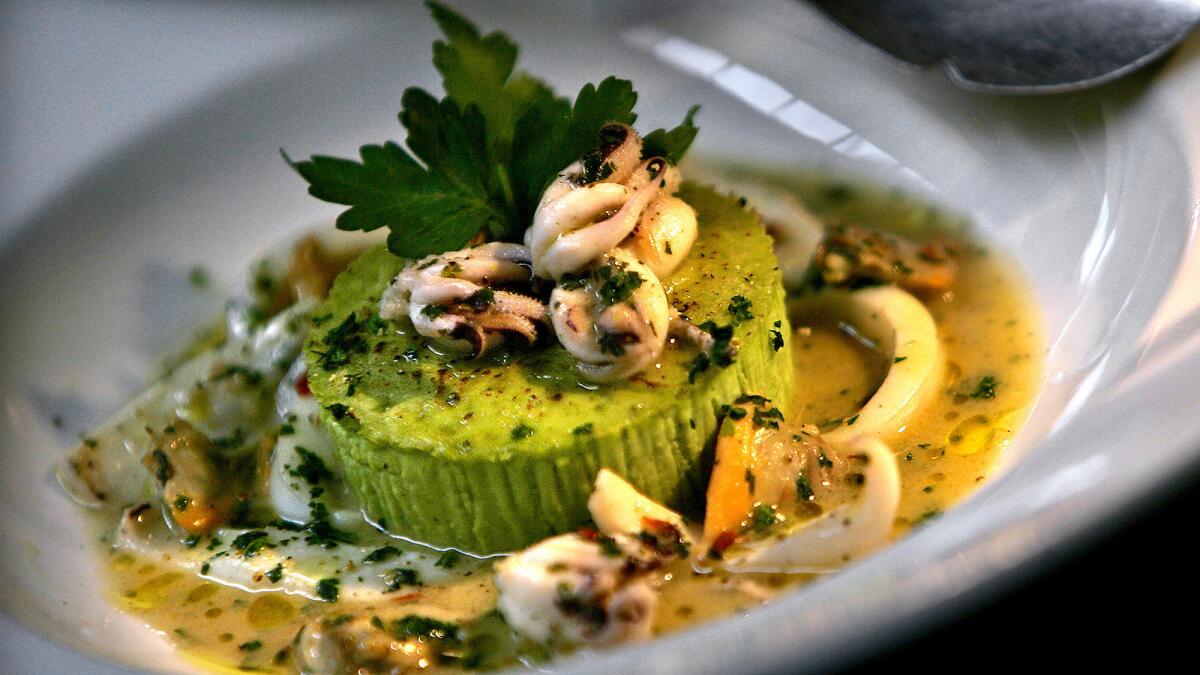
43 Vincenti Ristorante
Brentwood must be the world capital of a certain kind of Italian restaurant, the kind with carpaccio, tricolor salads and three kinds of pasta with vegetables, chicken under a brick and tiramisu. Brentwood is also where you will find Vincenti, which could pass as the go-to businessmen's restaurant in a large Italian city, with Nicola Mastronardi's superb roasted meats, pastas made with house-cured guanciale and the grilled cuttlefish salad against which all others are measured. Vincenti was born from the late Mauro Vincenti's Rex, the restaurant that did more than any other to introduce Los Angeles to sophisticated Italian cuisine.
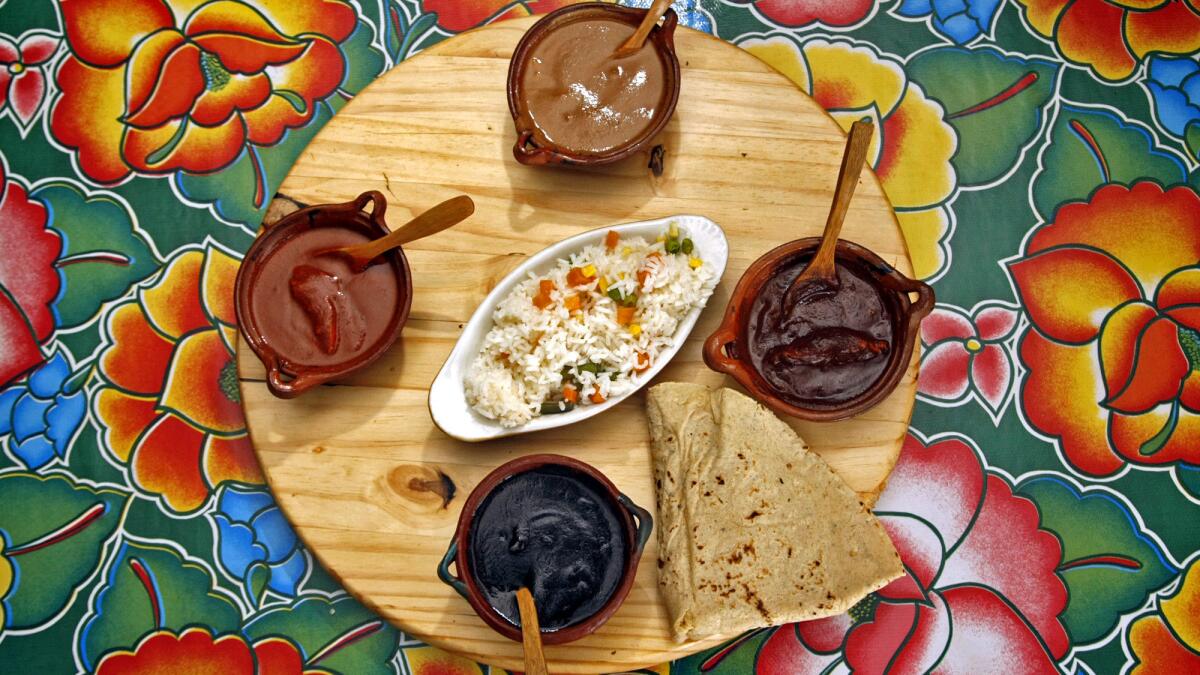
42 Guelaguetza
Sometimes I'm not sure what Los Angeles would do without Guelaguetza, which is practically the Oaxacan consulate in town; it's the prime mover in the mole thing and the birthplace of the local craze for mezcal. When you're in the mood for shared botana platters, you can get vast piles of white Oaxacan cheese served with lard-soaked memelas, the giant Oaxacan pizzas called tlayudas, heaps of fried empanadas or mole-soaked enmoladas, or even a platter with chicken, bowls of four kinds of mole sauce and the fresh tortillas to eat them with. If you're drinking, the micheladas are excellent — chile-spiked beers served in frozen, salt-rimmed mugs. After a few micheladas, you may have the courage to tackle a plate of the fried grasshoppers with chile and lime.
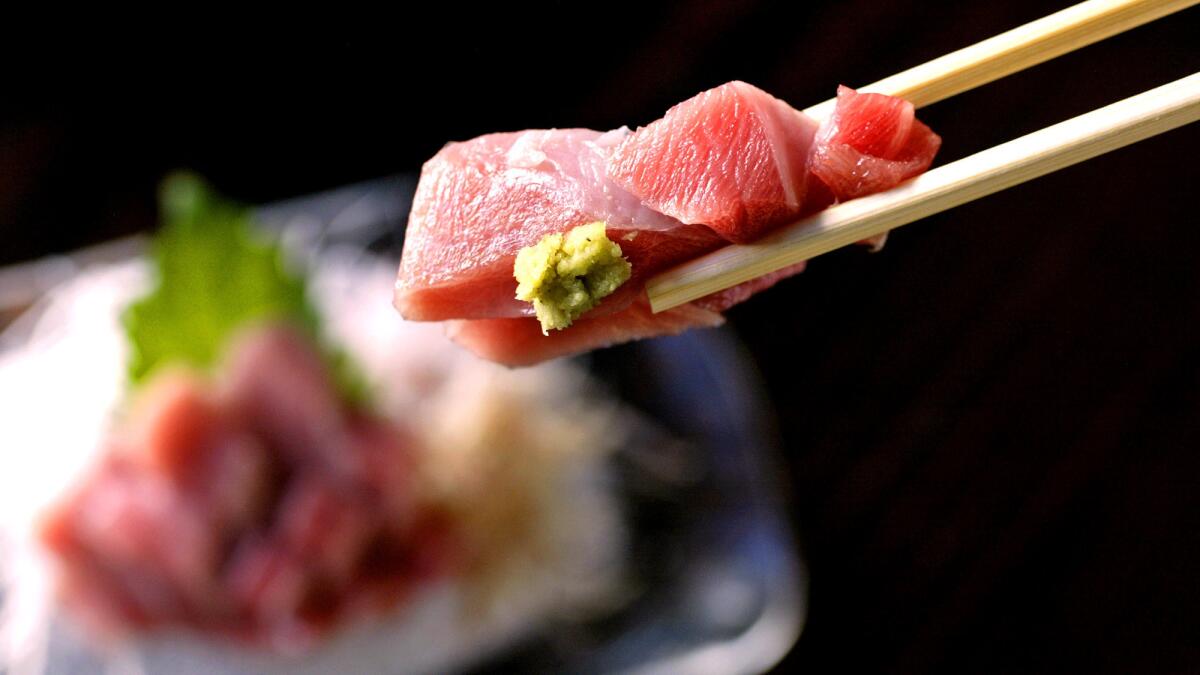
41 Kiriko
Sushi has never been easier to find in Los Angeles. Great sushi whose cost does not rival the price of an economy ticket to Narita is somewhat more difficult to locate. Of the fine sushi bars in Los Angeles, Kiriko is perhaps the least forbidding, a place where you know you can get perfect shirako or sea snail but which still treats mackerel with great respect; where the chef rejoices when bloody clams or baby octopus comes into season and where the great specialty is actually cherrywood-smoked salmon with mango, which you are unlikely to taste at Zo or Q. And while great sushi is never cheap, Ken Namba's traditional yet creative $80 omakase is almost a bargain.

40 Fig
If you follow local cooking events, you may know Ray Garcia as a hero to the nose-to-tail crowd, apt to remake Mexican tamarind candy with pig's blood or whip up offal-infused tamales that could make an abuelita weep with joy. Fig, his restaurant in the Fairmont Miramar in Santa Monica, is rather more sedate — a comfortable, airy farmers market-driven restaurant that never takes its diners too far from a comfort zone of baby kale salad, meatloaf, spinach-leaf lasagna, and red quinoa with chard and apples, although his bacon-wrapped bacon and veal tongue with tomatillo salsa have always had their fans. Will this be the year Garcia's transgressive side shows up at Fig? There are always the biscuits and gravy at breakfast.

39 Kogi
The Roy Choi phenomenon is worldwide by this point: the bestselling gangsta-gangsta food memoir, the throngs that show up at book signings and the patronage of Anthony Bourdain and David Chang, among other things. Kogi is credited with hot-wiring the Twitterization of American cooking, the food-truck craze, and the shotgun marriage of Korean flavors and the L.A. street taco. So sometimes it is good to step back a bit and realize that the miracle of Kogi lies chiefly in the four trucks that cruise Southern California every night and that Korean short-rib tacos, Kogi dogs and blackjack quesadillas taste really good, even if you do have to wait 30 minutes in line for them.
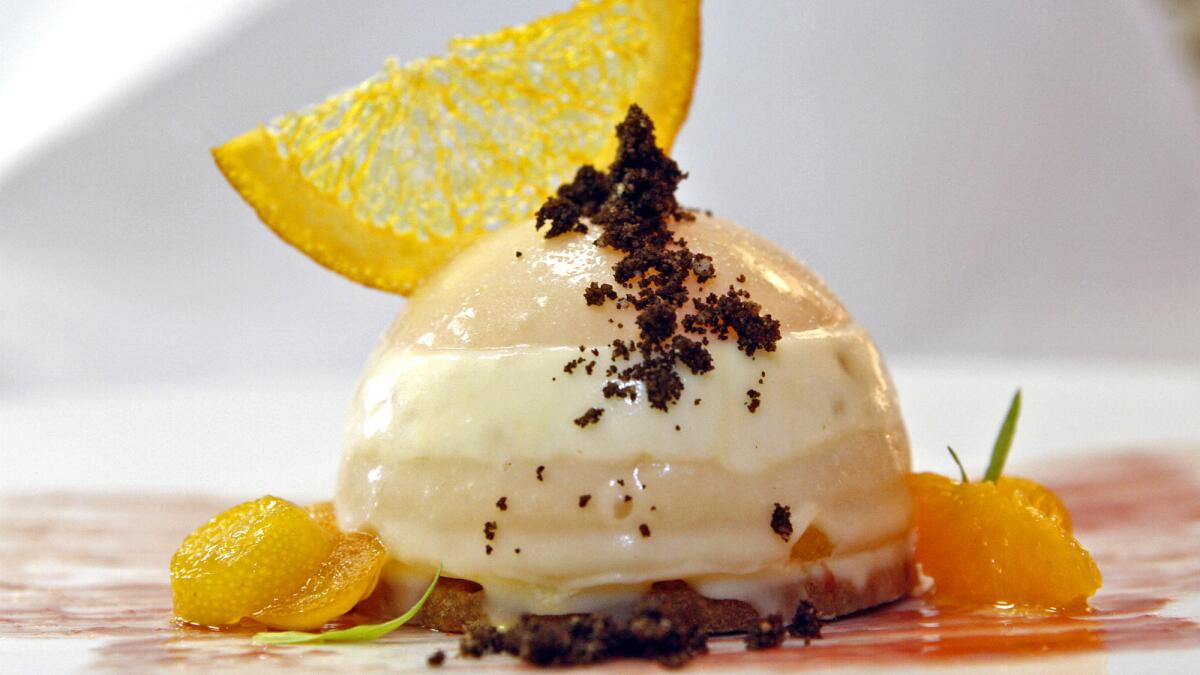
38 Hatfield's
The Hatfield's of the mind is probably a stubbornly idiosyncratic bistro in an off-center neighborhood, the kind of place you find pleasant and odd on your honeymoon, and are happy to discover 20 years later that it has remained exactly the same. Quinn and Karen Hatfield's elegant restaurant isn't small — it occupies the former premises of Citrus, one of the temples of California cuisine in the 1980s — and its neighborhood is not obscure. The clientele tends to be less romantic couples huddled over red wine-braised octopus and Champagne than entire sitcom writing rooms out for a working dinner. The cooking is still idiosyncratic and a bit more expensive than you think it is going to be. Both the date-crusted lamb and the yellowtail-enhanced croque madame are likely still to be on the menu in 2024. But it is possible to spot the contours of a modern tasting-menu restaurant here, as tempted as you may be to order the pork belly with lentils every time. The menu performs the great trick of being simultaneously unchanging and precisely seasonal. The Hatfields must do it with mirrors.

37 Barnyard
Is Barnyard a major destination restaurant? Because if your idea of an important meal involves sous-vide, a team of foragers and whole Berkshire hogs purchased from a small farm in Vermont, you're probably out of luck. Jesse Barber's gift is in his talent for deceptive simplicity — you are fooled into thinking that this is food you could prepare yourself if you had the time, that you are at Barnyard because it is pleasant and because you forgot to go to Whole Foods last night. This is an illusion. The menu at Barnyard, another one of those Westside places connected by umbilical cord to the Santa Monica farmers market, seems to change almost by the hour, but you can usually count on finding excellent terrines, grilled half-chicken brushed with reduced vin santo and crunchy, chewy risotto alla pilota.
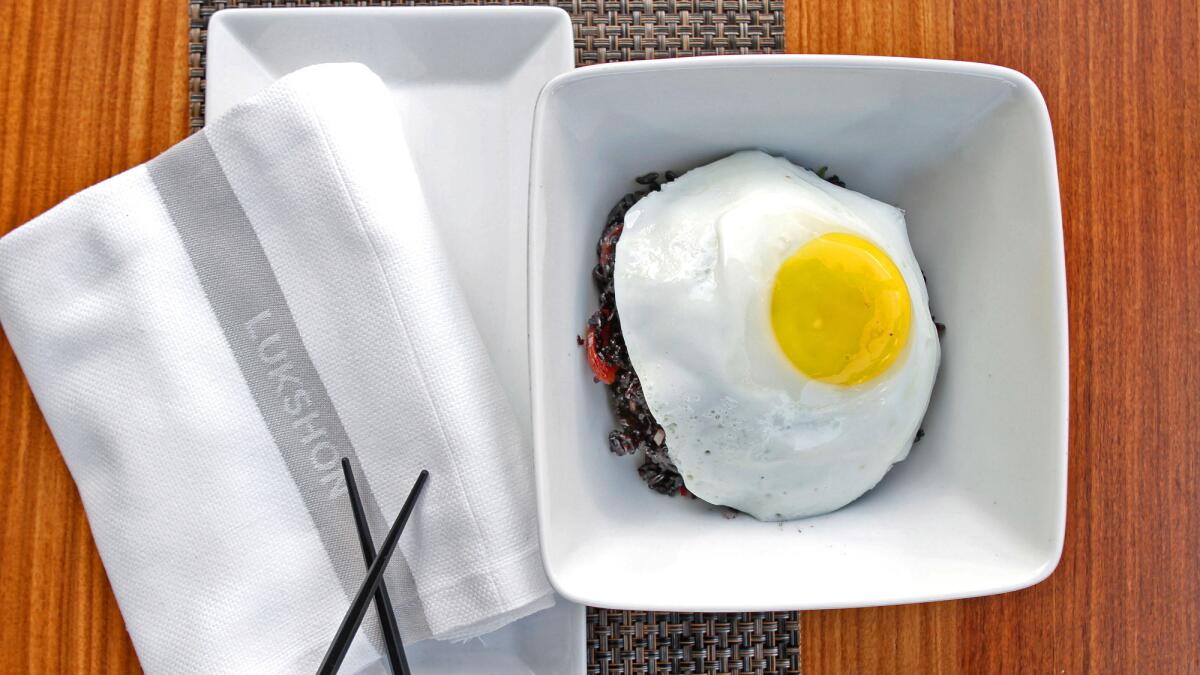
36 Lukshon
Do we have to talk about the no-ketchup thing? Because we can if you want to. Sang Yoon started the no-substitutions thing at his gastropub Father's Office, and you cannot get ketchup on your burger there. Yoon likes to do things his way. He was also probably the first chef in town to apply rigorous French technique to the Asian flavors he grew up eating. The cooking at Lukshon resembles nothing you will encounter in Taipei, Myanmar or Malaysia — his dan dan mian, tea-leaf salad and crab fritters approach the originals in intent, but they're his. What matters is that they taste good.
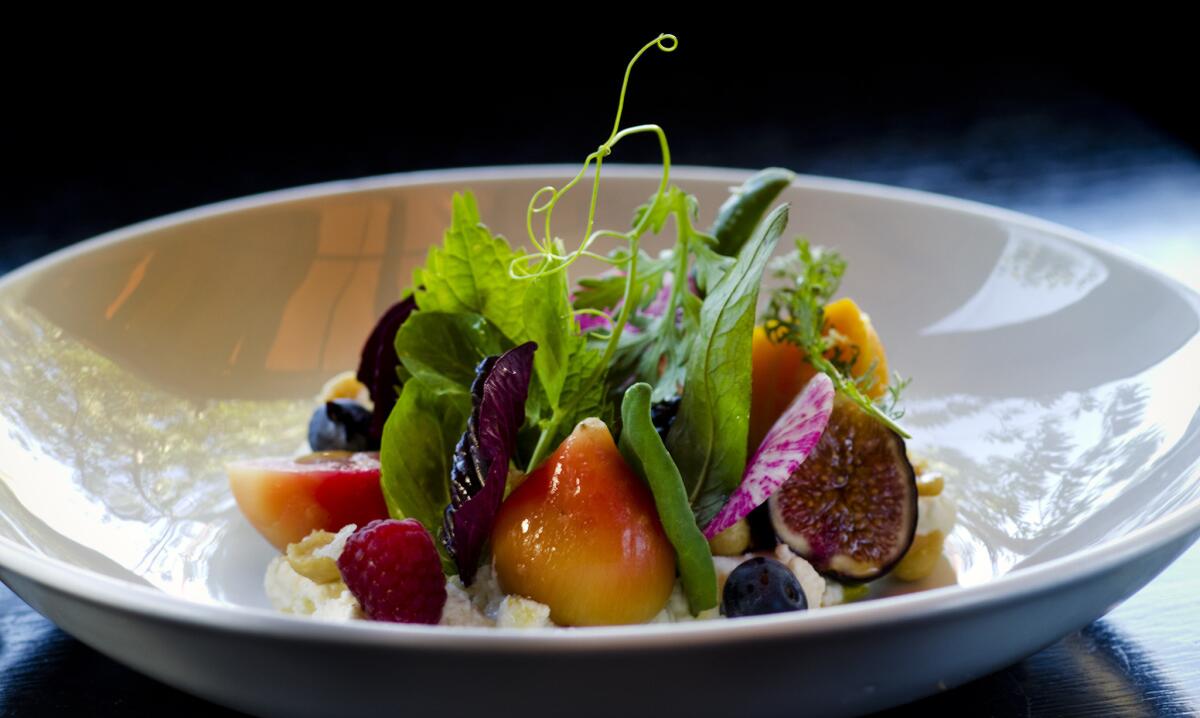
35 Girasol
You've probably run into Chris "CJ" Jacobson at your farmers market. He's the tall dude waving a jar of vinegar starter as if it were the keys to a new Tesla or hugging a crate of mulberries to his chest as if they might escape. A lot of chefs take produce seriously, but CJ seems to regard it, especially the foraged produce, they way a lot of us regard our pets. His Girasol in many ways is a typical Studio City restaurant, as popular for its strawberry ricotta crepes at brunch as it is for its fennel-crusted steelhead, but Jacobson's recent stay at Copenhagen's Noma shows. His talent may lie less in expressing L.A.'s cultural diversity than in layering the sunny fragrances of California onto what might seem to be straightforward New American cooking: the branch of yarrow with the meatballs, the cactus fruit in the mimosas and the charred pine needles dusting the steak.

34 Jar
A dozen years in, it seems almost a little odd to see Suzanne Tracht at her modern chophouse Jar, her ideas about Asian-inflected cooking limited to a first-rate chashu pork chop and a bit of lemon grass with the chicken; her mastery of the New American kitchen mostly directed toward big chunks of meat. She should be winning national awards, but she is content with making a great wedge salad and the best pot roast in town. But she's not slumming. Jar, which looks like a set from a Doris Day movie, is as timeless as a well-fitted A-line skirt. This is to say your grandparents would have liked it, although they may not have understood why the chicken was scented with kaffir lime leaf or why they had just been served sautéed pea tendrils instead of actual peas.
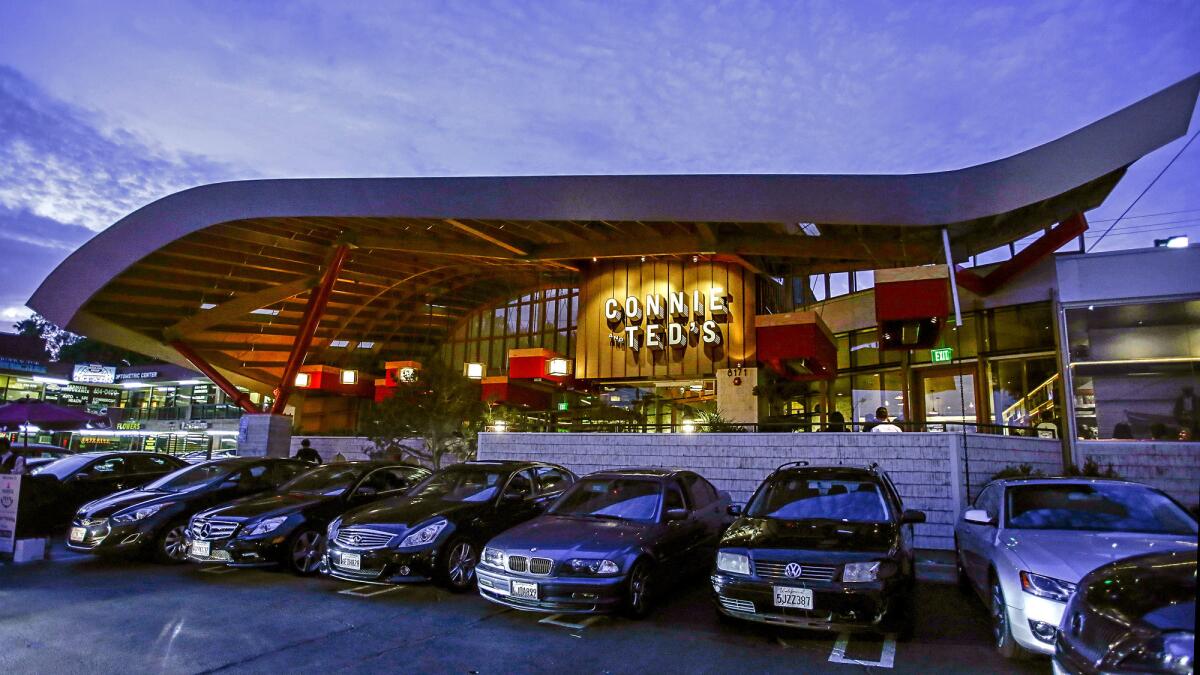
33 Connie and Ted's
Michael Cimarusti, it must be conceded, knows how to cook a fish. And while any New Englander worth her salt pork has remarkably specific preferences about how lobster rolls, stuffies, steamed cherrystones and clam chowder should be prepared, at his cavernous homage to Rhode Island shore dinners, Cimarusti has his own. So of the clam chowders on his menu, the one you want is the Rhode Island style, a grayish, salty distillation of the sea. The crisp fried clams are served either with or without their tender, juicy bellies. For the miracle known as stuffies, chopped quahogs are mixed with bread crumbs, sausage and sweet peppers, then stuffed back into their shells and baked until crisp. And there may be no restaurant in Los Angeles that treats its oysters with more reverence. Just to mix things up, Connie and Ted's also serves one of the best burgers in town, lavishly greased with Hook's cheddar and cooked to a bloody medium rare.

32 Bäco Mercat
Josef Centeno's kitchens may have been where the local convergence of haute cuisine and pub food began. His menu here reads almost like a graduate exam in culinary post-structuralism, mixing flavors and structures from Spain, France and western China, and Mexico and Peru. His ideal customer might be someone who knows what the Catalan almond sauce salbitxada is but who also doesn't get upset if she accidentally splashes a little on her shirt. A bäco itself is Centeno's invention, a kind of flatbread sandwich, halfway between a taco and a pita construction, stuffed with chicken salad, fried veal tongue or a complicated layering of that salbitxada, bits of pork belly and crunchy, porous cubes of what Centeno calls beef carnitas. Will you want a bowl of his noodle-enriched posole? You will, and some banana cream pie for dessert.

31 Guerrilla Tacos
An Alain Ducasse disciple quitting his job at an haute cuisine pop-up to serve charred octopus tacos on a downtown street corner? It happens. So while you can approach Wes Avila's Guerrilla Tacos as you would any other truck, making a lunch of an overstuffed taco and a bottle of Mexican pop, the tacos you get at Guerrilla, which parks outside a downtown coffee bar a few days a week, are pretty much the ones he decides to sell you, which are as likely to be stuffed with diver scallops, Tuscan kale or even French black truffles as they are to be heaped with shrimp or carnitas — carnitas Avila makes by slow-roasting Cook Pig Ranch pork shoulder. His biggest fans know to get there early: The lamb shoulder or sea urchin you've been craving may be sold out within minutes.

30 Tsujita
Tsujita ramen is unbelievably good: gossamer noodles in a complex broth made with chicken, Kurobuta pork and a bit of dried fish. The burlier version called tsukemen, dip ramen, may be even better, served with a reduced broth as a dipping sauce on the side. Even the simmered egg, its yolk a vivid, reddish-yellow custard, is superb. But in the restaurant's wisdom, the ramen and tsukemen are served only at lunchtime — dinner sees a multi-course, if noodleless, izakaya menu. The Tsujita Annex across the street serves ramen and tsukemen at both lunch and dinner, but a somewhat different if equally pork-intensive ramen, which might be delicious if you weren't thinking so hard about the ramen that you should be eating instead.
29 Marché Moderne
Visitors to Los Angeles are always surprised by the great strip mall restaurants here, by the unexpected discovery of transcendence in a storefront between the dry cleaners and the 7-Eleven. Visitors to Orange County, I suppose, are just as shocked to discover fine dining in mega-malls, the spiritual home of Mrs. Fields and Hot Dog on a Stick. But at the top of its escalator, Marché Moderne is an oasis of calm, an unexpected place of guinea hen with calvados and scallops with cauliflower mousseline, moules frites and bone marrow with dense sauce bordelaise — classic French bistro cooking with just the occasional modern hint of a chorizo emulsion or a yuzu gelee. The $25 prix-fixe lunch is one of the better bargains in Southern California.
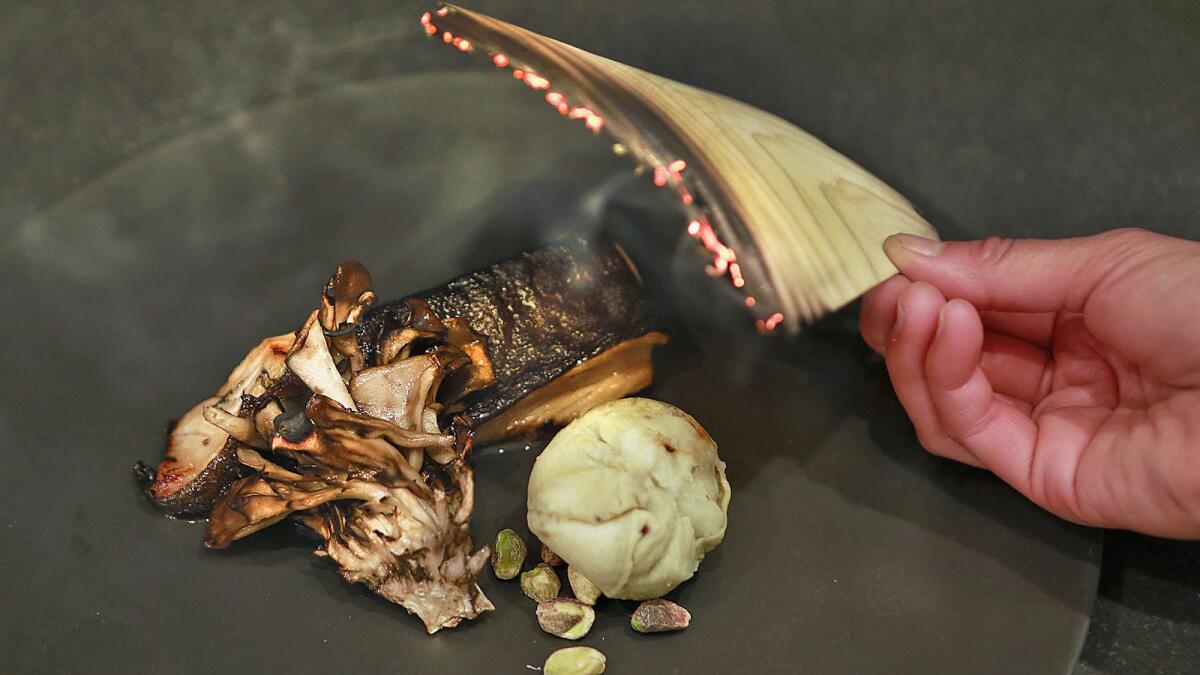
28 Hinoki and the Bird
The morning after a meal at Hinoki and the Bird, your memories tend to be complicated: steel-edged elegance and the fumbling of all the OK Cupid dates going on around you; wisps of cauliflower shaved over a coconut soup and the slightly gritty texture of the charcoal-infused buns used to make the lobster roll; the ethereal scent of cedar smoke on the salmon and the sour aftertaste of cocktailian overindulgence. Chefs David Myers and Kuniko Yagi are obsessed with the complex seasonal rhythms of kaiseki cooking. On the other hand, as the owner of Comme Ça as well as a small chain of Tokyo cafes, Myers is also a master of high-volume upscale dining. So is Hinoki and the Bird, hidden under a Century City skyscraper, a boozy small-plates restaurant reliant on luxury ingredients or an atmospheric Japanese restaurant overlaid with American excess? Kind of both.
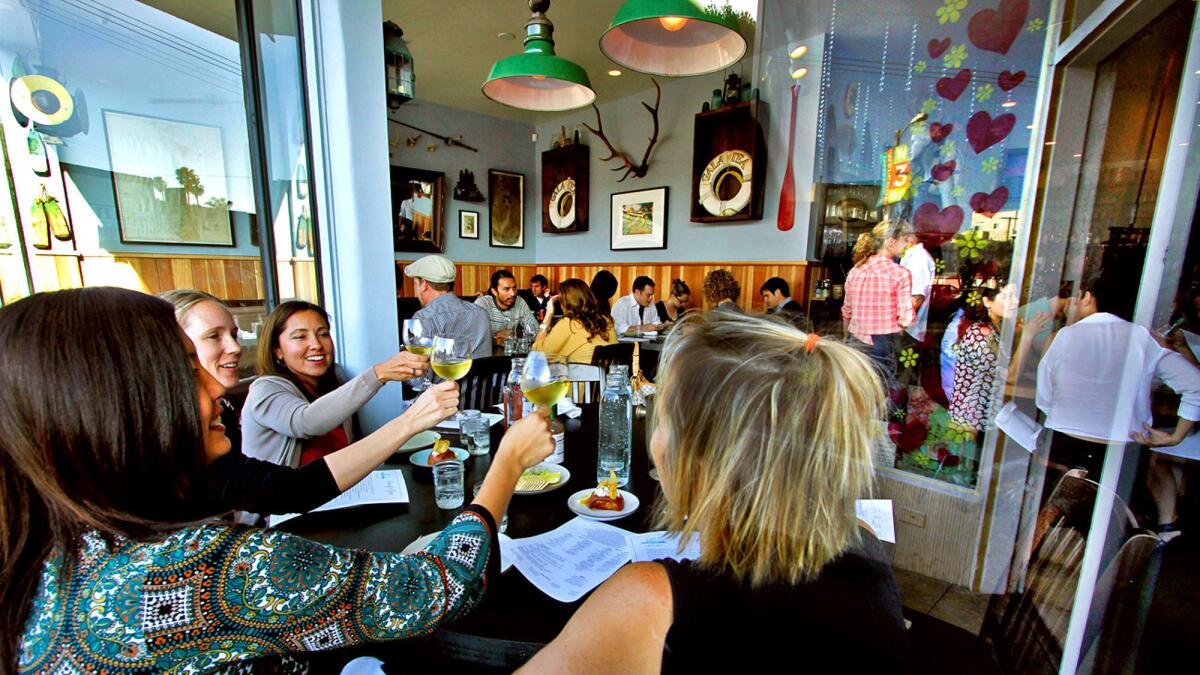
27 Son of a Gun
Pig guts are manly, as Jon Shook and Vinny Dotolo discovered at Animal. Seafood can also be manly, as at their Son of a Gun, as long as you get rid of the twee beurre blanc and court bouillon, concentrating instead on plunking grouper into ham broth, serving shrimp sandwiches on white bread and making sure that the amberjack sashimi and lemonfish poke are at least as chile-smacked as a street taco. Fried chicken sandwiches and big plates of Kentucky ham don't hurt. They just got rid of the communal tables, so it is both a bit harder to buttonhole your neighbor on the subject of hockey and to land a seat on a Saturday night.

26 Mélisse
If Angelenos are splashing three bills on dinner, they're probably going for sushi. So it is almost by force of will that Josiah Citrin's very French Mélisse, which is still the most formal restaurant to open in Los Angeles since the 1980s, maintains its momentum — not to mention its truffles, caviar, Wagyu beef and specially imported Uruguayan rice. Actually, compared to an omakase at Q, the $125 prix fixe may even be a bargain. There is an opulent vegetarian tasting menu these days, but Citrin's customers still look like the parents of the people who go to Animal.
READ MORE:
1-25
51-75
75-101